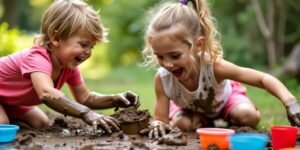
Exploring Nature in the Classroom: Outdoor Learning for Preschoolers
Preschoolers are naturally curious and full of wonder, making outdoor learning an ideal approach to engage and educate them. By venturing beyond the four walls of the classroom and immersing young children in the beauty and diversity of nature, we can provide them with invaluable learning experiences. This article will delve into the benefits of outdoor learning for preschoolers, the ways in which nature can be incorporated into the curriculum, and the importance of creating a safe and engaging outdoor learning environment. Additionally, we will explore various types of outdoor activities that promote cognitive, physical, and social development. By integrating science and environmental education in outdoor learning, enhancing gross motor skills through nature-based play, fostering creativity and imagination, and building a lifelong connection with nature, we can empower preschoolers to become passionate and responsible stewards of the environment.
The Benefits of Outdoor Learning for Preschoolers

1. Cognitive Development
Preschoolers have curious and active minds that thrive when given the opportunity to explore the great outdoors. Outdoor learning provides them with hands-on experiences that stimulate their cognitive development. Whether it’s observing insects, identifying plants, or solving nature-based puzzles, these activities promote critical thinking, problem-solving skills, and creativity. By engaging with the natural world, preschoolers also develop a greater understanding of concepts like cause and effect, patterns, and the interconnectedness of living things.
2. Physical Health and Well-being
Incorporating outdoor learning into the preschool curriculum allows children to engage in physical activities that promote their overall health and well-being. Whether it’s running, climbing, or jumping, outdoor play helps strengthen their muscles, improves coordination, and develops gross motor skills. Furthermore, exposure to natural light and fresh air contributes to their physical resilience and immune system. Outdoor learning not only encourages an active lifestyle but also helps reduce sedentary behaviors associated with excessive screen time.
3. Emotional and Social Development
Nature provides a rich environment for preschoolers to explore their emotions and develop important social skills. Being outdoors allows children to experiment with their senses, experience different textures, and regulate their emotions in a calming and soothing setting. Additionally, nature-based group activities and cooperative play foster teamwork, communication, and empathy. Outdoor learning also promotes independence, as children learn to take responsible risks and make decisions for themselves, building their self-confidence along the way.

Incorporating Nature into the Preschool Curriculum
1. Integrating Nature into Lesson Plans
Make nature an integral part of your lesson plans by incorporating outdoor activities and observations that align with the preschool curriculum. For example, when teaching about colors, take the children on a nature walk to explore and identify colorful flowers or leaves. When teaching about animals, organize a wildlife observation session where children can spot birds or insects in their natural habitats. By creatively integrating nature into lesson plans, educators can enhance children’s learning experiences and make them more engaging and memorable.
2. Creating Nature-based Learning Objectives
Set specific learning objectives that focus on nature-related topics and skills. For instance, aim to develop children’s knowledge of local plants and animals, their ability to identify different types of leaves or animal tracks, or their understanding of the seasons and weather patterns. By creating nature-based learning objectives, educators provide a framework for meaningful exploration and ensure that outdoor learning becomes an essential part of the curriculum.
3. Using Nature as a Context for Learning
Nature can serve as an inspiring context for various subjects, from science and math to language arts and art. Engage children in hands-on activities that connect their classroom learning to the natural world. For example, measuring and comparing the heights of trees can introduce concepts of measurement and data analysis. Writing or drawing about their outdoor experiences can enhance literacy and artistic skills. By using nature as a context for learning, educators create a deeper connection between children and their environment.
Creating a Safe and Engaging Outdoor Learning Environment

1. Assessing and Managing Risks
Before embarking on outdoor activities, it’s crucial to assess and manage potential risks. Conduct a risk assessment to identify any hazards in the outdoor environment and implement appropriate safety measures. Educators should also be trained in first aid and emergency protocols to ensure the well-being of the children during outdoor learning activities. By carefully managing risks, educators can create a safe and secure outdoor learning environment.
2. Designing an Outdoor Classroom
Creating an outdoor classroom space that is inviting and conducive to learning is essential. Consider providing natural materials such as logs, rocks, or tree stumps for seating or building structures. Arrange the outdoor space to allow for different areas of exploration, such as a sensory garden or a bird-watching station. Ensure that the outdoor classroom offers shade, protection from the elements, and access to necessary supplies. A well-designed outdoor learning environment encourages exploration, discovery, and engagement.
3. Ensuring Safety Measures and Procedures
Establish clear safety measures and procedures that are communicated to both the children and the educators. Teach children about the importance of staying within designated areas, respecting plants and animals, and following safety rules. Educators should have protocols in place for emergencies, including how to handle a sudden change in weather or an encounter with wildlife. Regularly review and update safety procedures to ensure the ongoing protection of all participants in outdoor learning activities.
Exploring Different Types of Outdoor Activities for Preschoolers

1. Nature Walks and Hiking
Nature walks and hiking trips are excellent opportunities for preschoolers to explore their surroundings and develop an appreciation for the natural world. Prepare simple identification guides for plants, animals, and natural features, and encourage children to observe and ask questions. These activities allow children to engage their senses, practice their observation skills, and learn about the diversity of plants and animals in their environment.
2. Gardening and Planting
Gardening provides preschoolers with a hands-on experience that connects them to the life cycle of plants and encourages responsibility. Set up a garden space where children can plant seeds, water plants, and watch them grow. Incorporate discussions about soil, sunlight, and the needs of plants into the gardening activities. Gardening not only teaches children about the natural world but also instills a sense of pride and accomplishment as they witness the fruits of their labor.
3. Wildlife Observation and Exploration
Encourage preschoolers to be curious about the wildlife around them and foster a sense of wonder for the natural world. Set up bird feeders or butterfly habitats where children can observe and learn about different species. Organize nature scavenger hunts or treasure hunts to engage children in active exploration. By providing opportunities for wildlife observation and exploration, educators help children develop a connection with their local ecosystem and a sense of responsibility for its conservation.
Remember, outdoor learning should be a fun and enriching experience for both preschoolers and educators. Embrace the opportunities to explore nature, foster a love for the outdoors, and create lasting memories that will encourage a lifelong appreciation for the natural world.
Integrating Science and Environmental Education in Outdoor Learning
When it comes to teaching preschoolers about science and the environment, there’s no better classroom than the great outdoors. By taking learning outside, we can engage young minds in hands-on experiments and investigations that make science come alive. From exploring the properties of water to observing the lifecycle of butterflies, these outdoor activities spark curiosity and nurture a love for the natural world. Plus, what better way to learn about ecosystems and biodiversity than by immersing ourselves in them? By observing plants and animals in their natural habitats, preschoolers can gain a deeper understanding and appreciation for the delicate balance of our planet. And let’s not forget about the importance of environmental stewardship and sustainability – by teaching preschoolers to care for the world around them, we’re fostering a sense of responsibility that will last a lifetime.

Enhancing Gross Motor Skills through Nature-based Play
Who said learning can’t be fun? When preschoolers step outside, they enter a world of endless possibilities for gross motor skill development. From climbing trees and balancing on logs to running through open fields and jumping over puddles, nature is the ultimate playground. By engaging in these activities, preschoolers not only improve their coordination and balance but also develop their strength and agility. And let’s not forget about the joy of splashing in water or digging in the sand – these sensory experiences not only enhance their gross motor skills but also provide endless opportunities for imaginative play.
Fostering Creativity and Imagination through Outdoor Exploration
When preschoolers step into nature, they enter a realm of boundless creativity and imagination. From using natural materials to create art and crafts to inventing stories and characters inspired by the world around them, outdoor exploration sparks the fire of creativity. Whether they are painting with leaves, building fairy houses, or staging an impromptu concert with the sounds of birds as their audience, preschoolers can let their imaginations run wild in nature. And let’s not forget about the joy of dancing in the rain or twirling among the flowers – music and movement take on a whole new meaning when surrounded by the wonders of the outdoors.
Building a Lifelong Connection with Nature through Early Experiences
The experiences we have in our early years shape us for a lifetime, and that includes our relationship with nature. By introducing preschoolers to the wonders of the natural world, we are nurturing a lifelong connection with the environment. Cultivating a sense of wonder and curiosity is key – whether it’s marveling at a ladybug or discovering a hidden trail, these small moments lay the foundation for a lifelong love of nature. Encouraging preschoolers to document their observations and thoughts in nature journals not only enhances their literacy skills but also deepens their connection with the world around them. And let’s not forget about the importance of involving families in these outdoor learning experiences – by engaging parents and caregivers, we can create a ripple effect that extends beyond the classroom and into the community.In conclusion, outdoor learning provides preschoolers with a multitude of benefits, from cognitive development to physical health and emotional well-being. By incorporating nature into the curriculum, creating a safe outdoor environment, and engaging in various activities, we can nurture their love for the natural world. Through these experiences, preschoolers develop important skills, gain a deeper understanding of science and the environment, and cultivate their creativity and imagination. By fostering a connection with nature from an early age, we are laying the foundation for a lifelong appreciation and stewardship of our planet. Let us embrace the power of outdoor learning and continue to inspire the next generation of nature enthusiasts and environmental advocates.
Frequently Asked Questions

1. Is outdoor learning suitable for all weather conditions?
Outdoor learning can take place in various weather conditions, as long as the safety of the children is ensured. However, extreme weather conditions such as heavy rain, storms, or extreme heat may require adaptations or alternative indoor activities.
2. How can outdoor learning be integrated into a structured preschool curriculum?
Outdoor learning can be integrated into a preschool curriculum by aligning it with learning objectives and incorporating nature-based activities into lesson plans. Teachers can create thematic units centered around nature, use outdoor environments as a context for learning, and incorporate hands-on experiments and investigations in the natural surroundings.
3. What safety precautions should be taken during outdoor learning activities?
Safety is of utmost importance during outdoor learning activities. Teachers and caregivers should conduct a risk assessment of the outdoor environment, ensure proper supervision at all times, establish safety rules and procedures, and educate children about potential hazards. It is also crucial to have a first aid kit readily available and to communicate with parents about safety protocols.
4. How can families support outdoor learning experiences at home?
Families can support outdoor learning experiences by encouraging their children to spend time in nature, exploring parks, gardens, and natural areas. They can also engage in nature-based activities at home, such as gardening or observing wildlife. Additionally, families can support the integration of nature into the curriculum by providing resources and materials related to the natural world and by fostering a sense of wonder and curiosity about the environment.


Ms. Kerri’s Corner provides a exciting virtual space for preschool learning. Through a variety of engaging activities, she exposes young minds to early math, literacy, science and social-emotional skills in a developmentally appropriate way. Centers for blocks, art, books and music allow children to explore hands-on learning at their own pace. Guided lessons subtly introduce number sense, letter sounds and narrative thinking. Careful observation gives insight into each child’s progress across domains. Viewers are also invited to participate, reinforcing that their ideas are valued. By making learning fun yet purposeful, Ms. Kerri lays the groundwork for future academic success while fostering creativity and imagination. Her program offers preschoolers valuable screen-based learning experiences.



